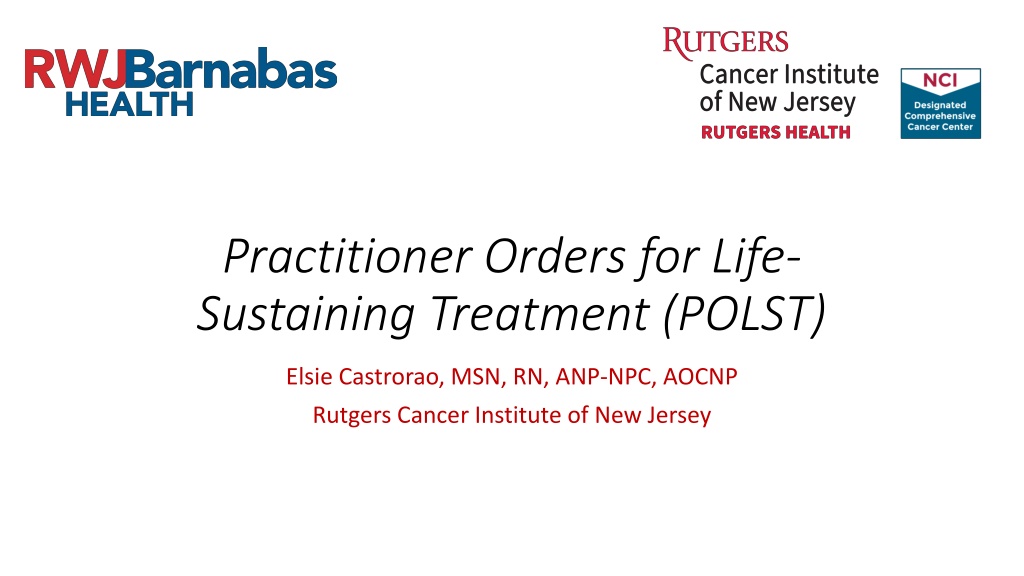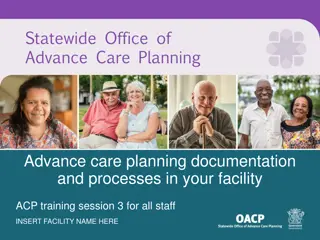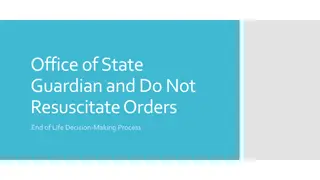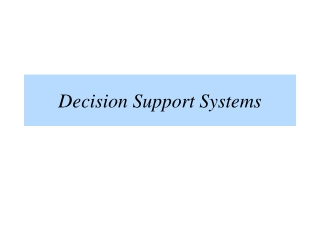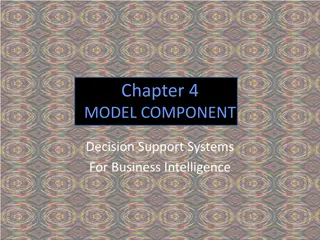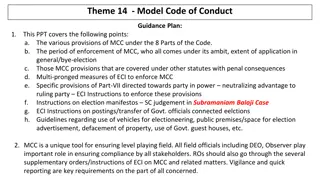Understanding POLST and Advance Directives in Healthcare Decision-Making
POLST, or Practitioner Orders for Life-Sustaining Treatment, is a healthcare planning tool that empowers individuals to articulate their medical preferences when facing advanced illness. Contrasting with Advance Directives, which are statements of patient intentions, POLST represents actionable medical orders that complement ADs. Developed to align patient preferences with treatment provided, POLST aids healthcare professionals in delivering desired care while avoiding unwanted interventions. This system includes sections to specify goals of care, allowing patients to express hopes and expectations regarding their treatment approach.
Download Presentation
Please find below an Image/Link to download the presentation.
The content on the website is provided AS IS for your information and personal use only. It may not be sold, licensed, or shared on other websites without obtaining consent from the author. Download presentation by click this link. If you encounter any issues during the download, it is possible that the publisher has removed the file from their server.
Uploaded on Apr 02, 2024 | 2 Views
Presentation Transcript
Practitioner Orders for Life- Sustaining Treatment (POLST) Elsie Castrorao, MSN, RN, ANP-NPC, AOCNP Rutgers Cancer Institute of New Jersey
What Does POLST Mean? What Does POLST Mean?
POLST POLST Healthcare planning tool that allow individuals to take charge of their health, by working with their medical providers to discuss their personal goals and medical preferences when facing advanced illness.
Differences Between Advance Directive And POLST Differences Between Advance Directive And POLST Advance Directives (AD) are statements of patient intention, not medical orders. AD initiated after a patient has been determined to have lost decision-making (DM) capacity. Statements of AD are interpreted by healthcare providers into medical orders to become active. AD are appropriate for anyone over 18.
Differences Differences POLST is appropriate for anyone with an advanced illness. POLST as a set of medical orders are immediately actionable/functioning-no interpretation needed. POLST complements an AD and does not totally replace it. Can be generated by a Physician or Advanced Practice Nurse (APN) with the patient or surrogate.
Why Was POLST Developed? Why Was POLST Developed? The goal was to provide a framework of care for healthcare professionals so they could provide the treatment patients DID want and avoid those treatments that patients DID NOT want.
POLST Form POLST Form
Section A Section A- -Goals of Care Goals of Care Not part of the medical order set. What is the care plan trying to achieve; cure, longevity, remission. What are the hopes of the patient?
Section A Section A- -Goals of Care Goals of Care Examples: Live as long as possible with freedom from pain and discomfort. Live long enough to attend a family event (wedding, graduation). Healthcare providers are encouraged to share information regarding. prognosis in order for the individual to set realistic goals.
Section B Section B- -Medical Interventions Medical Interventions Full treatment-no limitation on medical interventions if appropriate for example; ICU, intubation. - If in a nursing facility, transfer to hospital if indicated. Resuscitation status - indicated in section D. Limited Treatment-for example; antibiotics, IV fluids, non-invasive positive airway pressure. - Generally with limited treatment avoid intensive care. - Specify preference for transfer to hospital.
B B- -Medical Interventions Medical Interventions Symptom Treatment only Focus on comfort (for example to relieve pain, administration of medication by any route, oxygen, suctioning, wound care). Includes all measures to relieve spiritual, emotional and psychological suffering. Transfer to hospital (only if comfort cannot be achieved in other settings).
Section C Section C Artificially Administered Fluids and Nutrition Artificially Administered Fluids and Nutrition Always offer food/fluids by mouth if feasible and desired by patient. Artificial nutrition (tube, IV) yes, no, or trial period.
Section D Section D- - Left side: Cardiopulmonary Resuscitation (CPR) Left side: Cardiopulmonary Resuscitation (CPR) Person Has No Pulse and/or Is Not Breathing Person Has No Pulse and/or Is Not Breathing Attempt resuscitation/CPR. Do not attempt resuscitation (DNAR)/CPR- Allow Natural Death. If you check CPR here that will require selecting full treatment in section B.
D D- - Right side: Airway Management Right side: Airway Management (Person Is In Respiratory Distress With A Pulse) (Person Is In Respiratory Distress With A Pulse) Intubate/use artificial ventilation. Do not intubate-Use oxygen, non-invasive support, medications for comfort. Defined trial period of mechanical ventilation.
Section E Section E Completed Only If Patient Has Decision Making Capacity Completed Only If Patient Has Decision Making Capacity Patient s permission for surrogate to modify or revoke the NJ POLST orders. Any modification must be in collaboration with patient s physician/APN. Discuss with patient any prior existence of a healthcare proxy/representative designated in an AD and avoid conflict by naming a different surrogate in this section.
Section F Section F- -Signatures Signatures Must be signed by patient with capacity or designated surrogate decision maker for patients who lack capacity. Physician/APN must print name and license number, sign and print date and phone number.
NJ POLST Specifics NJ POLST Specifics Reverse side of POLST, always copy as two-sided. Place to print person s name, address and date of birth. Place to print surrogate s name, address and phone number. Original (GREEN) stays with patient. Copies for medical record (two-sided-can be copied on white paper).
Key Points Key Points Filling out a POLST form is entirely voluntary for individuals with advanced illness. Having a conversation with an individual about end-of-life issues is an important and necessary part of good medical care. Physicians/APNs are responsible for the final clarification of those preferences and documentation of the appropriate orders on the POLST form.
Key Points Key Points The original POLST form on green paper, stays with the individual at all times. If a patient is transferred to another setting, the original POLST form goes with him/her. At home, individuals should place the original form in a visible location so it can be found easily by emergency medical personnel.
Key Points Key Points The POLST form can be modified or revoked by an individual with DM capacity, verbally or in writing, at any time. Changes can be made by the individual s legally recognized surrogate, in collaboration with the individual s physician/APN. It is good clinical practice to review an individual s POLST form when the individual is transferred from one medical setting to another, if there is a change in the person s health status or with a new diagnosis, and/or the treatment preferences change.
Conclusion Conclusion POLST is a medical order form that empowers individuals by carefully detailing their personal wishes. POLST translates the intentions found in an AD into an actionable order that every member of the healthcare team understands and respects those choices. Your quality of life during advanced illness should be totally under your control.
POLST POLST A complete listing of states using POLST: www.POLST.org https://www.youtube.com/watch?v=1oelG7Rrgts
